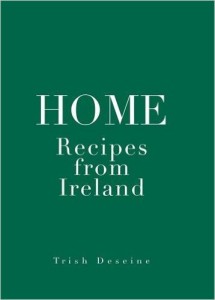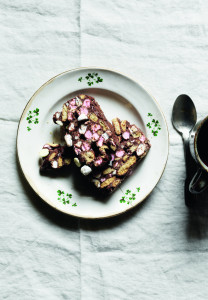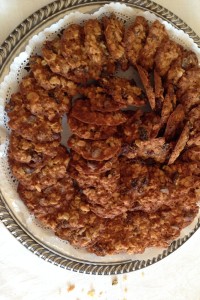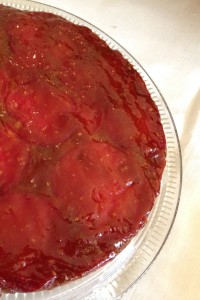I’ve recently been given a copy of Counter Culture, the Sheridan’s Guide to Cheese. I simply can’t put it down. What a gorgeous book, for me a romp down memory lane. A long overdue overview of the Irish farmhouse cheese industry, an appreciation of the charismatic, passionate and often deliciously eccentric people who has devoted their lives to producing beautiful cheeses from the milk of their dairy herds. Cow, goat and sheep’s milk cheese of many types that have helped in no small way to change the image of Irish food both at home and abroad. One after another they have won top prizes in cheese awards not just in these islands but also in the World Cheese Awards.
Is it any wonder that our cheeses are so good when we can grow grass here in Ireland like nowhere else in the world, consequently  many of our very best foods come from our rich lush pastures and summer milk. And who better to write this book but the Sheridan brothers, Kevin and Seamus Sheridan who established Sheridan’s Cheesemongers in 1995 with a cheese stall at the Galway Saturday Market. Their enthusiasm and deep knowledge charmed even the most reluctant passer-by to taste their latest find and gradually they converted the ardent Calvita eaters into farmhouse cheese lovers. Since then, the business has expanded to include four shops, a wine bar with a carefully choosen list to complement their wide range of Irish, British and European cheese. There’s a thriving wholesale and export business. The brothers’ food and business ethos is still firmly rooted in the simplicity of their first market stall. Their passion for food and respect for those who produce it has led them to be at the forefront of an exciting revival in Ireland’s culinary heritage. Seamus and Kevin are tireless advocates for sustainable food and farming. They are both devotees of the Slow Food Movement. I always remember my first meeting with Seamus at Slow Food Terra Madre in Turin in the 1980’s. He bounced up to me all tousled hair and big grin with a distinctively cheesey smell emanating from his rucksack. He proudly showed me the deliciously ripe Cashel Blue cheese he’d brought all the way from Tipperary to share proudly with Carlo Petrini and entice him and many other cheese makers to come to Ireland to taste the growing number of farmhouse cheeses and artisan products.
This book written in collaboration with Catherine Cleary of Irish Times tells the lovely story of the boy’s childhood, their inspirational parents and the experiences that shaped them, holidays spent milking cows, turning hay, digging turf, chewing dillisk, experiences which gave them a deep appreciation of real food.
And it’s not just about Irish farmhouse cheese. The chapters on the Origins of our Dairy Culture and the Science of Cheese are fascinating and you’ll soon be an expert on the differences between fresh cheeses, blooming rinds, washed rind, pressed uncooked cheeses and the pressed blues cooked cheeses.
There are some great photos and recipes for Kevin, Seamus and Catherine’s favourite ways to showcase the beautiful cheeses.
Hot Tips
Book of the Week – vegan was a word scarcely understood by the general public a decade or so ago but now regularly discussed in the media as more and more people stop eating animal products for ethical and health reasons.
A vegan diet is not just vegetarian but also excludes all dairy products, eggs and anything derived from animals or insects including honey. Many have espoused this way of eating in recent years including Bill Clinton, Al Gore, actress Natalie Portman say how much better and more energetic they feel.
The Vegan Bible by Marie Laforêt, published by Grub St, has over 500 tempting recipes which illustrates the richness and diversity of vegan gastronomy.
Handmade imported ceramics – Jenny Rose of The Sandwich Stall in the English Market has started to sell pottery wholesale….beautiful handcrafted Puglian, Spanish and Tunisian pieces…..food looks great.
Jenny-Rose, The Old Creamery, Toons Bridge, Macroo, Co Cork
Martry Mill is located on the River Blackwater near Kells, Co Meath and is a traditional watermill run by the Tallon family producing stoneground wholemeal flour of exceptional quality and flavour.
Contact James Tallon 086 817 3205 or www.martrymill.ie for list of stockists.
Past students Paul McVeigh and Jamie O’Toole are gathering rave reviews with their delicious food but in particular their signature dish the featherblade steak at Featherblade on Dawson Street, Dublin. Try the crispy confit chicken with hot Korean sauce, garlic and chilli prawns on toasted sourdough…. http://www.featherblade.ie/
Baked Camembert with Apple Crisps and Calvados Syrup
As the nights get chillier there’s nothing better than bringing a whole baked Camembert in its box to the table, oozing creamy warmth. This recipe also celebrates the sweetness of the apple season to set us up for winter.
Serves 4 as a meal or 6 as an after dinner alternative to a cheeseboard
For the apple crisps
3 medium-sized apples, peeled and cored
2 tablespoons sunflower oil
2 tablespoons maple syrup
a pinch of salt flakes
For the cheese
1 whole Camembert in its box
2 cloves garlic, peeled and sliced into thin slivers
1 tablespoon fennel seeds
2 sprigs of fresh rosemary
olive oil for drizzling
30ml maple syrup
2 tablespoons Calvados
Preheat the oven to 180°C/350°F/gas mark 4.
Cut the apples into thin, round slices as finely as you can (a mandolin works brilliantly). Place some parchment paper on a baking sheet and lay the slices on top – be careful that they don’t overlap (you may need several baking sheets).
Mix the sunflower oil, maple syrup and salt together in a bowl and drizzle this over the apple slices.
Bake in the oven for 10–15 minutes, until the edges are brown and crimped. Remove from the oven – they will crisp up as they cool.
While the crisps are baking, unwrap the Camembert and slice off the top rind. You can discard this or eat it on a cracker if you like, as a cook’s perk. Place the cheese back in its box and press the garlic slivers, fennel seeds and rosemary sprigs into it. Finally, drizzle a little olive oil over the top.
While the apple crisps cool, bake the cheese in its box on a baking tray in the oven for up to 20 minutes.
Meanwhile, heat the maple syrup and Calvados together in a small saucepan over a medium heat and bring them to the boil. Boil gently for two minutes, stirring.
Arrange the apple crisps around the baked Camembert and drizzle the Calvados syrup over the hot cheese to serve.
Taleggio Tartiflette
It’s no coincidence that tartiflette is a classic après-ski dish. It’s a rib-sticking, cockle-warming lump of a meal, best used as a reward after strenuous activity. But it’s so delicious you can simply take a smaller helping if your step count doesn’t warrant a heftier one.
Serves 4
1kg (2¼ lb) potatoes, peeled and cut into 1cm dice
rapeseed oil
2 thick rashers smoked streaky bacon, cut into 4cm dice
1 large onion, peeled and diced
½ glass Eight Degrees Brewing Barefoot Bohemian Pilsner Lager
350g (12 oz) Taleggio,
diced 1 garlic clove, peeled and cut in half
sea salt and freshly ground black pepper
Preheat the oven to 200°C/400°F/gas mark 6
Boil the potatoes for 3–5 minutes until just tender and then drain them and season with salt and pepper.
Heat a good splash of rapeseed oil in a large, heavy pan over a gentle heat. Fry the potatoes for a minute or two and then add the diced bacon and onion. Cook until the bacon has begun to crisp.
Pour in the Pilsner, stir and then add the cubed cheese. (You could also add some spinach, chard or kale at this stage.)
Remove the pan from the heat. Prepare an ovenproof earthenware dish by rubbing it well with the halves of garlic and greasing with rapeseed oil. Empty the contents of the pan into the dish and bake for 20–30 minutes, until the cheese has melted and begun to crisp.
Â
Durrus and Potato Pizza
This lets the rind sing! Potatoes on pizza might sound a bit much but they’re surprisingly good. The trick is to slice them very thinly and only use a single layer so they don’t make everything too claggy and thick.
Serves 6
375ml (13 fl oz) warm water
1 teaspoon dried yeast
110ml (3½ fl oz) olive oil
salt and freshly ground black pepper
600g (1¼ lb) 00 flour
3 sprigs of fresh rosemary
6 cloves garlic
2 medium Rooster potatoes, peeled
1 large sweet potato, peeled
250g (9 oz) crème fraîche
360g (12½ oz) Durrus, sliced
To make the dough, pour the water into a jug and mix in the yeast, smoothing it against the sides to ensure it’s dissolved. Add 50ml of the olive oil and 1 teaspoon of salt to the liquid. Pour into a bowl with the flour and mix to form a dough. Leave for 10 minutes. Turn the dough on to an oiled surface and knead lightly until it comes together. Put it back in the bowl, cover and leave for 90 minutes to prove.
Meanwhile, remove the leaves from the rosemary sprigs and combine in a mortar and pestle with the garlic and a pinch of salt. Bash this into a paste and then add the remaining olive oil. Transfer the entire mixture to a saucepan and heat the oil gently for about 10 minutes. Turn the heat off and leave the oil to infuse with the garlic and rosemary flavours.
Roll out the dough and dimple it with your fingers.
Fold it over like a sheet on itself and dimple again before rolling and repeating this a second and third time. Return the dough to the bowl to rest for a further 30 minutes.
Divide the dough into three and roll into rounds or rectangles, whichever you prefer. Preheat the oven to 220ºC/425°F/gas mark 7 – or as high as it will go!
Finely slice the potatoes and sweet potato into paper thin rounds and arrange them on the pizza bases in a single layer. Dot the potatoes and sweet potato with blobs of crème fraîche and place the slices of Durrus in between the blobs.
Finally, drizzle the pizzas with the garlic and rosemary oil and give them a good sprinkling of freshly ground black pepper.
You can strain out the rosemary shards or leave them in, whichever you prefer. Bake the pizzas for 10 minutes and serve immediately.
Salad of Mozzarella, Poached Pears, Air-dried Lamb and Hazelnut
A beautiful salad that bridges the gap between summer and winter. The secret to this recipe is a good balsamic vinegar and fresh mozzarella. We are lucky to have buffalo mozzarella from Toby Simmonds’s Toons Bridge Dairy in Co. Cork delivered fresh to our shops.
Serves 6
2 or 3 pears, peeled, halved and cored
750ml (25½ fl oz) water
½ vanilla pod
100g (3½ oz) sugar
½ cinnamon stick
1 large buffalo mozzarella, torn into shreds or chopped
150g (5 oz) Connemara air-dried lamb, thinly sliced and cut into small shreds (if you can’t find air-dried lamb you could use a good prosciutto)
100g (3½ oz) mixed leaf salad
50g (2 oz) hazelnuts, toasted and chopped
For the vinaigrette
2 tablespoons olive oil
2 tablespoons balsamic vinegar
1 teaspoon honey
1 teaspoon mustard
Place the pears in a large saucepan with the water, the seeds from the vanilla pod, the sugar and the cinnamon. Poach the pears over a medium heat until soft. Leave to cool in the syrup. Once cooled, slice the pears and combine on a large serving plate with the mozzarella, lamb and leaves.
Whisk the vinaigrette ingredients together in small bowl and, just before serving, drizzle over the salad and then sprinkle with the toasted hazelnuts.





